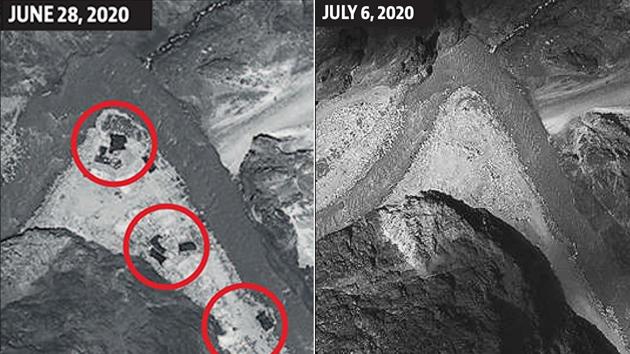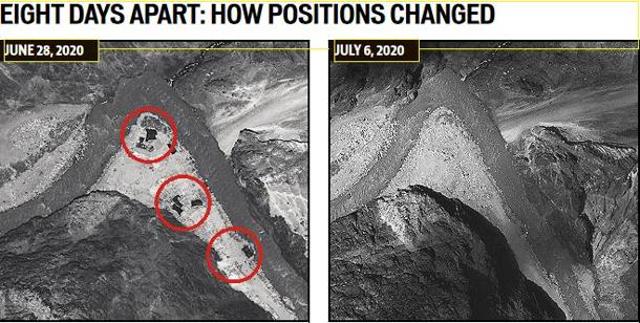4km buffers at three key points as troops pull back from Ladakh clash site
The two armies have already created a 4km buffer zone in Galwan Valley, the site of a deadly clash which left 20 Indian and an unconfirmed number of Chinese soldiers dead on June 15, said a second official.
The Indian Army has begun a rigourous verification process to monitor the withdrawal of the Chinese People’s Liberation Army (PLA) from friction points along the Line of Actual Control (LAC) in eastern Ladakh even as a complicated disengagement plan moved forward in Hot Springs and Gogra, where the two armies are working to create a 4km buffer zone between troops within a 24-hour time frame, four officials familiar with the developments said on Tuesday evening.

The PLA has withdrawn up to 2km from Patrolling Point 15 (Hot Springs) and a similar retreat is expected to be completed at PP-17 (Gogra) by Wednesday evening, with the Indian Army pulling back proportionately. This is based on an understanding reached last week by top Indian and Chinese military commanders on a phased de-escalation of the ongoing border conflict in the Ladakh theatre, said one of the officials cited above, who spoke on the condition of anonymity.
The two armies have already created a 4km buffer zone in Galwan Valley, the site of a deadly clash which left 20 Indian and an unconfirmed number of Chinese soldiers dead on June 15, said a second official.
The creation of buffer zones will temporarily restrict the patrolling activities of both armies in the region. While some experts saw this as a necessary step, others cautioned that the temporary curtailing of patrolling rights should not become a long-term feature undermining Indian presence and control.
Hindustan Times reported on Tuesday that the PLA had withdrawn up to 1.5 km from friction areas in Galwan Valley, Hot Springs and Gogra, and the Indian Army also pulled back proportionately. A minor thinning of PLA soldiers has been noticed at the sensitive Finger Area near Pangong Tso.
Satellite images on Tuesday appeared to confirm the PLA pullback from Galwan Valley. “The images clearly indicate that the PLA has moved back in Galwan Valley. It’s a positive step but constant verification and strict vigil are a must,” said Lieutenant General Vinod Bhatia (retd), a former director general of military operations. Bhatia reviewed the images for HT.

The disengagement effort involves rival troops pulling back a specified distance from face-off sites, with further retreat taking place in phases as the complex plan progresses on a verifiable basis on the ground every 72 hours by both sides. It also entails the phased withdrawal of weapons and equipment to a mutually agreed distance, and finally the restoration of status quo ante (the situation as it existed in early April).
“The army is keeping a close watch on the ongoing pull back by the PLA. It’s extremely critical to verify and reverify every stage of the disengagement process to avoid surprises,” said the second official, who asked not to be identified.
The verification process launched by the army involves unmanned aerial vehicles, other aerial means of surveillance and satellite imagery of the areas, said a third official.
The Indian Air Force (IAF) is already projecting its capabilities of carrying out day-and-night, all-weather combat missions in Ladakh, with front-line fighter jets, attack helicopters, and multi-mission choppers getting airborne for demanding night-time missions from a forward airbase in the area, people familiar with the matter said on Tuesday.
On the creation of buffer zones, and the curtailment of patrolling, experts had a mixed response.
“The zones of separation will eliminate the possibility of violent face-offs. It’s best to avoid any form of contact between rival troops. A moratorium on patrolling the areas by both sides till things stabilise should help,” said former Northern Army commander Lieutenant General DS Hooda (retd).
Disengagement during a 2014 border standoff at Chumar in Ladakh involved a temporary ban on Indian and Chinese soldiers patrolling disputed areas.
Satisfactory progress of disengagement in Galwan Valley, Hot Springs and Gogra could set the stage for reducing tensions in the Finger Area and also turn the focus on the Depsang plains where the PLA’s forward presence is hindering the Indian Army’s patrolling patterns, said Hooda.
But others sounded a more cautionary note, emphasising that India must be able to — after the agreed period — exercise its patrolling rights again. A senior official said India must never lose track of China’s “salami slicing” tactics to slowly grab territory. “Salami slicing” refers to a string of small, clandestine operations meant to achieve a larger goal that would be difficult to accomplish in one go. He said, “We have to ensure that the buffer zones do not become a new status quo. These can only be a temporary measure to facilitate the disengagement process to restore status quo ante. The army will fully exercise patrolling rights in the area once that happens.”
Before the PLA occupied vantage positions on Finger Four in early May, Indian Army soldiers would patrol right up to Finger Eight, which New Delhi considers to be its territory. The new Chinese positions have restricted the scope of Indian patrols. Fingers Four and Eight are 8km apart.
The army is also keeping a strict vigil along the contested border in the Depsang sector where a 2013 Chinese intrusion blocked the access of Indian soldiers to several patrolling routes, including the ones leading to Patrol Points 10, 11, 11A, 12 and 13, a fourth official said.
The military buildup in Indian and Chinese depth areas, however, hasn’t thinned, with both sides keeping their guard up. The deployment of thousands of soldiers, fighter jets, helicopters, tanks, artillery guns, missile systems and air defence weapons continues in the region.
The disengagement process, a precursor to any kind of de-escalation of the border conflict, has started under the terms mutually agreed to at the June 30 meeting between delegations led by Lieutenant General Harinder Singh, commander of the Leh-based 14 Corps, and Major General Liu Lin, commander of the South Xinjiang military region. This understanding, in turn, was the result of earlier efforts not paying dividends.
Get Current Updates on India News, Lok Sabha Election 2024 live, Infosys Q4 Results Live, Elections 2024, Election 2024 Date along with Latest News and Top Headlines from India and around the world.



